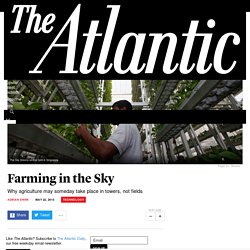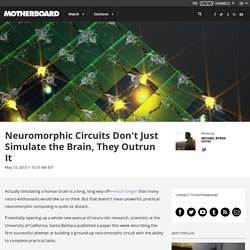

Scientists Just Automated Designing Light-Based Computers. Your computer ferries data around using electrons and conductive wires; for now, anyway.

The age of electronics could soon end, maybe even within the next decade, thanks to an algorithm that can automatically design components that use light instead of electrons. Currently, sending electrons around a computer using conductive wires consumes up to an estimated 80 percent of a computer’s processing power. Basically, wires are a bottleneck when it comes to processing speed. Sending data with light, similar to fiber optics but at a micro-scale, would allow computers to process much more data, and much faster. Although much promising work has been done in this area, a real and constant concern is the cost of building light-based components.
Now, they’ve actually built components using the program, and they work. A influência da epopéia de Gilgamesh na escrita do Gênesis. “O passado das civilizações nada mais é que a história dos empréstimos que elas fizeram umas às outras ao longo dos séculos ...” 1.

Da “corrida ao ouro bíblico” à nova historicidade das sagradas escrituras. Em meados do século XIX, após a descoberta na antiga cidade de Nínive da biblioteca do imperador assírio Assurbanípal (668-627 a.C.), o mundo redescobriu as antigas grandes civilizações da Mesopotâmia em tábuas de argila contendo escritos em sinais mais tarde denominados cuneiformes. Civilizações estas de que até então, o pouco que se conhecia estava contido nos livros da Bíblia, em informações “escassas e pouco reveladoras, uma vez que estavam diretamente relacionadas com a história do povo hebreu”.
Farming in the Sky. A couple of Octobers ago, I found myself standing on a 5,000-acre cotton crop in the outskirts of Lubbock, Texas, shoulder-to-shoulder with a third-generation cotton farmer.

He swept his arm across the flat, brown horizon of his field, which was at that moment being plowed by an industrial-sized picker—a toothy machine as tall as a house and operated by one man. The picker’s yields were being dropped into a giant pod to be delivered late that night to the local gin. And far beneath our feet, the Ogallala aquifer dwindled away at its frighteningly swift pace. Apple and Google push Obama to prevent encryption backdoors. This Microscopic Beam Splitter Could Enable Light-Based Computers.
The word “electronics” may become a misnomer faster than anyone expected.

Computer engineers at the University of Utah have made a major breakthrough in the world of optical computing, creating a light beam splitter 50 times thinner than a human hair. This innovation—one that various engineering teams have been chasing for years—paves the way for a new kind of computing altogether, where computers send signals within the machine using light instead of electrons. John McAfee Defends the Security Researcher Who Hacked Airplanes Mid-Flight. John McAfee, everyone's favorite fugitive and unhinged former CEO, is defending security researcher Chris Roberts, who made headlines last week after the FBI claimed he hacked into an airplane mid-flight through vulnerabilities he found in its in-flight entertainment system.

According to a search warrant application, Roberts told the FBI he hacked into the control systems of Airbus and Boeing aircraft, using a modified ethernet cable to connect to a port on the Seat Electronic Box (SEB) located underneath the passenger seat. It said that on at least one occasion, he slightly increased the thrust of the plane's right engine, causing it to veer slightly to the left.
Roberts also admitted to running similar tests 15 to 20 times between 2011 and 2014, the document states. He was detained in April after he tweeted a joke about how he could hack a plane while aboard a United Airlines flight to Syracuse, New York. Bill Gates, Steve Jobs? Tudo começou no Estado! Google Just Made Near-Infinite Storage Cheap and Easy. Have an extra petabyte of data sitting around?

Today the company that has already amassed a huge chunk of the world’s data has made it easier to sock away a whole lot more. This morning Google announced what it’s calling Google Cloud Storage Nearline, a cloud-based version of an old-fashioned way to store massive amounts of data too important to delete but not important enough to keep close. The service is designed for companies with very large storage requirements — on the order of hundreds of terabytes. Traditionally, businesses that want to archive data at that scale have turned to offline or “cold” storage, meaning that the data isn’t immediately available, usually because it’s stored on tape drives or other media and filed away in a vault somewhere. Neuromorphic Circuits Don't Just Simulate the Brain, They Outrun It.
Actually simulating a human brain is a long, long way off—much longer than many neuro-enthusiasts would like us to think.

But that doesn't mean powerful, practical neuromorphic computing is quite so distant. Potentially opening up a whole new avenue of neuro-sim research, scientists at the University of California, Santa Barbara published a paper this week describing the first successful attempt at building a ground-up neuromorphic circuit with the ability to complete practical tasks. To emphasize: This is not an algorithm or software model, as is usually considered within neuro-computational research, but the bare circuit itself, consisting of metal-oxide semiconductors (CMOS) and somewhat exotic components known as memristors. The result? A 100 neuron brain featuring some limited but promising visual recognition abilities.
Pós-proletariado, a nova classe social das ruas. Guy Standing é PhD pela Universidade de Cambridge e professor de Estudos do Desenvolvimento da Escola de Estudos Oriental e Africano da Universidade de Londres.

Os super-ricos e o resto. Brazil é uma distopia satírica dirigida por Terry Gilliam, em 1985.

Spiders Spin Super Silk After Being Spritzed with Graphene. Spiders spritzed with a carbon nanotubes or graphene particle solution were discovered by researchers in Italy to produce a stronger than usual super silk, opening up the possibility of some kickass materials hitting the market in the future.

Graphene is widely touted as one of the world’s strongest artificial materials, and is made of sheets of carbon, which are just one atom thick. In the organic world, spider’s silk—which has been perfected over 400 million years of evolution—is like its natural equivalent. Cientistas contestam causa humana do aquecimento global. Recommended Reading: Can Apple avoid a fate similar to IBM? Recommended Reading highlights the best long-form writing on technology and more in print and on the web.
Some weeks, you'll also find short reviews of books that we think are worth your time. We hope you enjoy the read. Apple Won't Always Rule. Just Look at IBM. by Jeff Sommer The New York Times Apple's growth is staggering. [Image credit: Apic/Getty Images] The Information Age Is Over. Welcome to Infrastructure Age. Transforming all donated blood into a universal type. What do you do when a patient needs a blood transfusion but you don't have their blood type in the blood bank?
It's a problem that scientists have been trying to solve for years but haven't been able to find an economic solution - until now. University of British Columbia chemists and scientists in the Centre for Blood Research have created an enzyme that could potentially solve this problem. The enzyme works by snipping off the sugars, also known as antigens, found in Type A and Type B blood, making it more like Type O. Type O blood is known as the universal donor and can be given to patients of all blood types. "Terceirizações devem acelerar a expansão do precariado no Brasil"
Economista com Ph.D. pela Universidade de Cambridge e professor de Desenvolvimento na Escola de Estudos Orientais e Africanos da Universidade de Londres, Guy Standing há tempos alerta para o fenômeno da emergência do precariado, uma nova classe trabalhadora em formação, caracterizada pela trajetória de perda de direitos que os reduz à condição de suplicantes, em um mundo marcado pela “flexibilização” das relações trabalhistas. Autor do livro O Precariado: A Nova Classe Perigosa (Editora Autêntica, 2013), ele é entusiasta de programas de renda básica, entendido como uma garantia incondicional e universal, uma vez que os antigos instrumentos de proteção da socialdemocracia trabalhista acabaram solapados pela onda neoliberal.
Has the First Person to Achieve Immortality Already Been Born? Jiajing wasn’t the first or last to pursue everlasting youthfulness. It has been the stuff of legend and fantasy since we first began dreaming. Fantasy, legend, dreams—the realms of the supernatural but never the scientific. Until now. This Is What the Fourth Industrial Revolution Looks Like. It’s 7 AM, April 13th, 2025. Your smart clock rouses you from a dreamless sleep and you climb from bed as your house comes to life. The bathroom light turns itself on and the shower begins to heat its water. Mind Uploading Will Replace the Need for Religion. Zoltan Istvan is a futurist, author of The Transhumanist Wager, and founder of and presidential candidate for the Transhumanist Party. He writes an occasional column for Motherboard in which he ruminates on the future beyond natural human ability. four billion When you think about it, trying to wrap your brain around how digital technology and all its wonders are even possible is simply bizarre.
This working computer is smaller than a grain of rice. Computers used to consume whole rooms, but now one computer can fit on the edge of a nickel. At just one millimeter cubed, the Michigan Micro Mote (M^3) is the smallest autonomous computer in the world. For over a decade, the faculty and students at the University of Michigan's computer science department have been working on the M^3.
As the Internet of Things (IoT) gets bigger, the Michigan team is pushing to make computers ever smaller. "The Internet of Things describes a world in which everyday common objects have intelligence - like a toaster, a washing machine, or doorknob. All of those things will someday have integrated circuits in them that can talk to each other over a network," said Dag Spicer, senior curator at the Computer History Museum in Mountain View, Calif.
Despite its tiny size, the M^3 has the ability to take pictures, read temperatures and record pressure readings. Forget Dams: Let's Store Extra Energy in Rocks on Trains and Underwater Balloons. Renewables are abundant, but they tend to make themselves available at inconvenient times—the wind often blows strongest at night, when the lights are off—and in out-of-the-way places, like sunlight in the desert. In order to get more from renewables, we need a better storage solution than even the most advanced batteries, which aren’t likely to store anywhere near what we need or what renewables produce. So far, the main large-scale storage option is even more inconvenient than the renewables themselves. Pumped hydro storage is an ingenious, 100-year-old solution that uses no fancy science, only physics and engineering: falling water turns turbines to run a generator that produces electricity.
The US Navy Doesn't Need an Expensive Aircraft Carrier Drone. 3D-Printed Kidney Tissue Is Here. Organovo has been working on printing functional human tissue since being incorporated in 2007, and first printed a cellular blood vessel in 2010. Since January 2014, it has offeredbioprintedliver tissue (marketed as exVive3D™ liver tissue) for companies to use in drug trials and disease modeling, and it looks as though its bioprinted human kidney tissue will be used for the same tasks, starting sometime in the latter half of 2016. "Kidney represents an ideal extension of capabilities to 3D bioprint organ tissues that can be tremendously useful in pharmaceutical research," Keith Murphy, Organovo's chairman and CEO, said via press release. “The product that we intend to build from these initial results can be an excellent expansion for our core customers in toxicology, who regularly express to us an interest in having better solutions for the assessment of human kidney toxicity.
" The Perfect Birth Control for Men Is Here. Why Can't We Use It? Holawhat? Meet The Alt-Management System Invented By A Programmer And Used By Zappos. SpaceX Warns Fake Competitors Could Disrupt its Space Internet Plan. The biggest impediment to SpaceX's plan to create a worldwide, satellite broadband network might not be the sheer technological difficulty of putting 4,000 satellites into space. Stoya Explains When It's OK to Pirate Porn. Here's a List of the Best Pirate Bay Alternatives, Courtesy of the US Government. The Biosensors of the Future Can Be Drawn on With an Ordinary Ball-Point Pen. Google Researchers Demonstrate Breakthrough Needed for Quantum Computing. Software rot. Are We Headed for 'Peak Code'? Not Likely. Problem loading page. Moore’s Law Is About to Get Weird - Issue 21: Information. The New American Dream? Let the Robots Take Our Jobs. When SpaceX Takes Photos on a NASA Mission, Copyright Law Explodes. Produtividade do Capital. Trabalho produtivo e improdutivo.
Sobre o conceito de proletariado em Marx: situando um debate (Coleção Princípios) Assalariados urbanos: proletariado ou nova classe média? (parte 1) The Race to Replace Bitcoin. Inside the Chinese Bitcoin Mine That's Making $1.5M a Month. Dirty Money and Development by Sri Mulyani Indrawati. The 'Better Siri' that Could Plan NASA Missions and Help You Organize Your Day. The Very Real Future of Iron Man Suits for the Navy. How US Special Forces Uses Google Maps. The End of Endless Growth: Part 2. How Laws Restricting Tech Actually Expose Us to Greater Harm.
This Is the Robotic Chicken Butcher of Our Nightmares. Why has human progress ground to a halt? – Michael Hanlon. NYU Polytechnic Has Interns Do Cheap Engineering Work for Startups. Technology To Automate A Third Of U.K. Jobs Over Next 20 Years, Says Deloitte. We Need to 'Chill' About Artificial Intelligence, Says Founder of Robot Company. Robots Are Coming for Your Job, But Only If You're Poor. The End of the Throw Away Appliance. ALIENAÇÃO NO TRABALHO: (re)visitando o conceito na atual era da informação e do conhecimento. Economia da produção de informação - Wikiversidade. ALIENAÇÃO NO TRABALHO: (re)visitando o conceito na atual era da informação e do conhecimento.
Era da informação e meios de produção. Untitled document. ALIENAÇÃO NO TRABALHO: (re)visitando o conceito na atual era da informação e do conhecimento. CyTA. CyTA. Conseqüências sociais do uso da Robótica - Mecatrônica Atual. As novas tecnologias e a emergência da sociedade informacional. Do Capitalismo para o Digitalismo: 05.03 Especialistas de todos os saberes uni-vos. Do Capitalismo para o Digitalismo: 05.03 Especialistas de todos os saberes uni-vos.